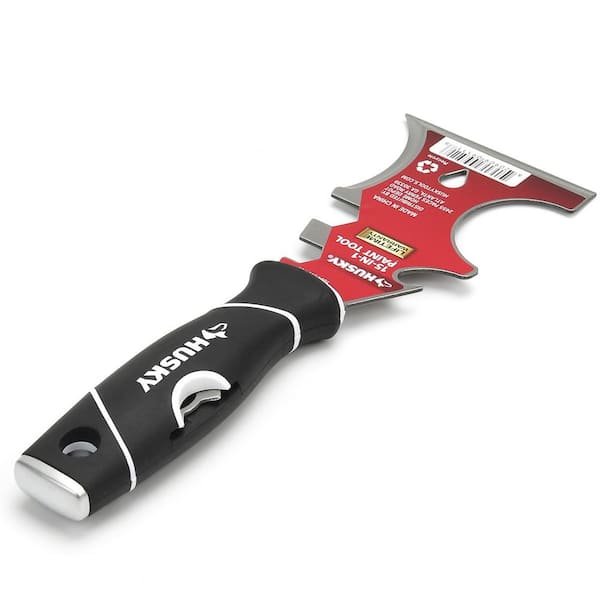Our youngest son, K2, started his service in the Navy recently, so I am borrowing from an old armed forces adage for today's title. Following seas, K2. On topic, Boo and I are continuing on our NewOldHouse journey, and today's post is about preparing for paint. I say preparing because we haven't gotten to the actual painting part yet. Maybe next week? Who knows, but I'll post part 2 when it happens.
Interior Cleaning
I have mentioned a few times just how grody the NewOldHouse is, or was. After the crawlspace was cleared of rubbish and new vapor barrier installed, things were decidedly better. Then, the floors were cleaned, sanded, stained and sealed. More better. Next for the interior (excepting the kitchen and bathroom), is painting the walls and ceiling. I used to paint houses for a living, so I know how to do this, but before we could paint, we wanted to clean and clear the space. This starts with protecting the floors with paper and plastic so the nice new floors are not damaged. Then, we removed all of the electric outlet and switch covers. Those steps are fast. Next, we started washing the walls and ceiling with TSP (or some similar cleanser). Since this house was so gross, we went with the more industrial TSP rather than something weaker. YMMV. Regardless of what you use, it takes a long time to mop walls and ceilings.
Exterior Scraping
After all that inside-focus, I felt the weather change looming. I have written about this feeling before, and how it effectively drove the effort to get Zed painted before mid-Summer. Well, here we are in autumn and we have a beater-house with peeling 30+ year old paint on it. I hit it hard with the power washer, and thought that would have loosened the paint. I did remove some, but there was more remaining than I expected. I focused on the front and sides for my first weekend of scraping, and after about 10 hours, I had those 3 sides mostly scraped. I did the rear over the course of a few week-day evenings that following week and finished everything the following weekend. I used 2 tools: first what I call a "5-way" that has a sharp-ish blade perpendicular to the handle that is bluff on one end and pointy on the other. I used this tool to pick at paint bubbles and splits to try to lift the paint. If I could, I would grab the edge with a gloved hand and pull the paint off. Regardless, once I got what I could in an area with the 5-way, I would use an old-skool scraper. A classic paint scraper has a handle that's about a foot long with a rectangle on the end in which sits a 2-sided scraping bar. That bar will grab paint edges, peeling or chipping it away -or- it will grind down a paint edge, if it is holding to the siding. The end result is the loose paint comes off and the transition from not-painted to painted is smoothed. Once paint is applied, these transitions are far less visible afterwards. This is strenuous work, however. After spending 2 weekends pushing scrapers, I load up on Monday with ibuprofen for recovery.
 |
| 5-way on steroids |
Delaying Exterior Repairs
When you get close enough to your siding to scrape it, you really see every imperfection. Regardless, I knew I had another day of driving nails and shooting caulk before I can cover windows and doors with plastic for shooting paint. I also found some failing areas that will need more attention. I expect that I will get the siding good enough and paint-shot to protect the house this year and will repair wood areas next year, and hand-brush the repairs as I go. The alternative could push the whole painting effort into the rain, and that changes the paint material choices since you can't paint water-based paint in the rain and expect a decent result. The soffits have some rot and the roofers did not clean above the soffits before installing the new roof, so there is work there. I will not get to this due to time constraints. I also found at least one lower window sill with some rot damage (see image on the right). Again, I do not have the time to fully resolve, so I will protect the damage as best I can with a plan to perform more major repairs when the weather changes (or when I can afford to pay someone else to do it).
I was able to walk the outside with a box of nails and a framing hammer, however. I re-set every nail that I could see, to get the siding to sit as tight as it could with the existing fasteners. When I could still hear a hollow thump when I struck the siding with the handle of the hammer, I sent in another nail. I repeated this until the thumps were solid. I also replaced all of the missing corner pieces as I went.
Next, I will caulk the windows and doors, and eventually get to hanging plastic and shooting paint. Fortunately, the weather forecast is holding for the next week. So, I figure I will spend a few after-work evenings caulking this week, and if all goes well, next weekend I will mask and paint.
Thanks, as always, for following along. I know this isn't car content. Once the house is done enough for move-in, I will be getting to car projects again. All good things in all good time-


No comments:
Post a Comment